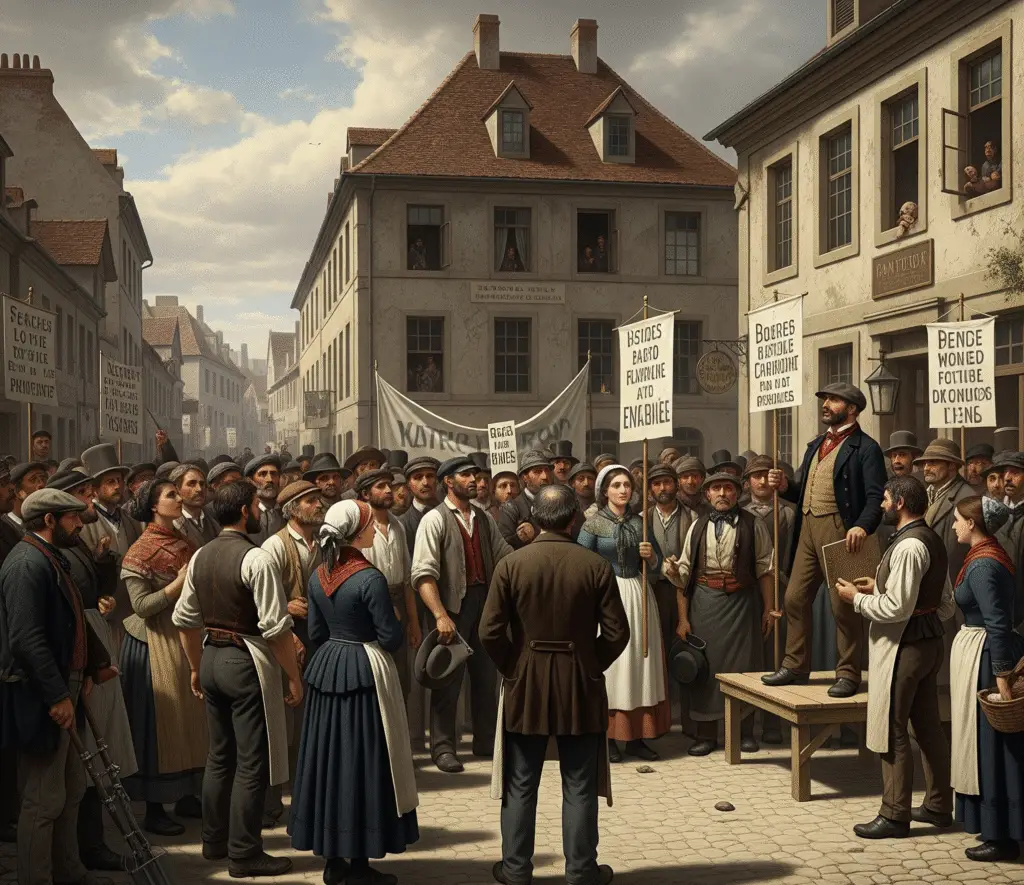Introduction to the Manifesto of the Communist Party
The Manifesto of the Communist Party was authored by Karl Marx and Frederick Engels in late 1847 and published in February 1848. It was commissioned as the programme for the Communist League at their Second Congress held in London from November 29 to December 8, 1847. The decision was made to present the League’s programme as a Manifesto, moving away from the catechism style common for secret societies at the time. This choice was seen as more suitable for providing a substantial exposition of their new revolutionary world outlook and comprehensively formulating the aims and tasks of the proletarian movement. Engels had previously drafted a programme in catechism form titled “Principles of Communism” in October 1847, which itself was a revised edition of an earlier draft (“Draft of a Communist Confession of Faith”) written in June 1847 for the League’s First Congress. However, Engels suggested abandoning the catechistic form for a manifesto in a letter to Marx in November 1847, recognizing the need for a more historical and public presentation of their ideas. The manuscript was completed by Marx, who worked on it intensively in January 1848, and sent to London for printing shortly before the February 1848 revolution in France.

The Manifesto addressed itself to a mass movement with historical significance, intended to outlive the immediate conditions, unlike documents focused on immediate demands, such as the “Demands of the Communist Party in Germany”. The Manifesto announced the advent of communism, a “spectre haunting Europe,” and declared that it was high time for Communists to openly publish their views, aims, and tendencies to counter misrepresentations.
The Historical Context and Core Principles
Engels noted in the 1888 English preface that, in 1847, “socialism was a middle-class movement, communism a working-class movement”. Socialists at the time included adherents of utopian systems like the Owenites and Fourierists, who had become mere sects, and various “social quacks” who proposed remedies without harming capital or profit. These groups were outside the working-class movement and sought support from the “educated” classes. In contrast, the section of the working class that recognized the inadequacy of mere political revolutions and demanded a radical reconstruction of society called itself Communist. This form of communism, though often “crude, rough-hewn, purely instinctive,” was powerful enough among the working class to produce utopian systems like Cabet’s and Weitling’s. Given their fundamental principle that “the emancipation of the workers must be the act of the working class itself,” Marx and Engels unequivocally chose the name Communist.
The fundamental proposition or basic thought underlying the Manifesto, which Engels attributes solely and exclusively to Marx, is that economic production and the social structure arising from it form the foundation for the political and intellectual history of any epoch. Since the dissolution of primitive communal ownership, history has been a history of class struggles between exploiters and exploited, oppressors and oppressed classes at various stages of social evolution. This struggle, the Manifesto argues, has reached a stage where the oppressed class, the proletariat, can only emancipate itself from the exploiting class, the bourgeoisie, by simultaneously and permanently freeing the whole of society from exploitation, oppression, class distinction, and class struggles.
The Manifesto describes how modern bourgeois society, which emerged from the decline of feudal society, has simplified class antagonisms into two main hostile camps: the Bourgeoisie and the Proletariat. The Bourgeoisie is defined as the class of modern capitalists who own the means of social production and employ wage labor. The Proletariat is the class of modern wage laborers who lack their own means of production and must sell their labor power to live. This relationship is inherently unequal, with the bourgeois having the advantage.
The Manifesto recognizes the historically revolutionary role of the bourgeoisie. It rose as a class contesting with feudalism. Driven by the need for constantly expanding markets, the bourgeoisie revolutionized production, created a world market, and established its political dominance in the modern representative state. This state, which originated to serve nascent bourgeois society against feudalism, evolved into an engine of class despotism for the enslavement of labor by capital as industry developed and intensified class antagonism.
However, the very development of modern industry and the bourgeoisie also creates its “grave-diggers” – the proletariat. As the bourgeoisie grows in wealth, the proletariat grows in numbers, concentrating in cities where industry is most profitable. This concentration gives the proletariat a consciousness of its own strength. Simultaneously, technological advances depress wages, making the proletariat’s condition increasingly unbearable, thus preparing the way for a proletarian social revolution.
The Manifesto critiques various other contemporary socialist tendencies, providing insight into the political and ideological landscape of 1847.
- Reactionary Socialism (Feudal and Petty-Bourgeois): Arising from classes ruined by the bourgeoisie (aristocracy, medieval burgesses, small peasants), this socialism looks backward, seeking to restore old modes of production or property relations. Feudal Socialists, like the French Legitimists and “Young England,” lampoon the bourgeoisie but ultimately lack comprehension of modern history and ally with coercive measures against the working class. Petty-Bourgeois Socialism, like Sismondi’s school, acutely dissects production contradictions but is ultimately reactionary and utopian in its aim to restore old conditions or cramp modern production within old limits. Christian Socialism is seen as merely a religious cover for feudal socialism. Communists are energetically opposed to these reactionary socialists.
- German or “True” Socialism: This form is presented as a philosophical abstraction of French socialist literature, introduced into Germany when the bourgeoisie was still struggling against feudalism. German literati translated French ideas without their corresponding social conditions, turning practical demands into philosophical concepts like “Alienation of Humanity”. This “True” Socialism lost practical significance, opposed liberalism and bourgeois freedoms, and served absolute governments as a scarecrow against the bourgeoisie, while simultaneously representing the interests of the German petty-bourgeois Philistines. It was characterized by abstract nonsense and opposition to class struggles, ultimately swept away by the 1848 revolution.
- Bourgeois Socialism: Adherents of existing society frightened by its inherent evils. They propose mere welfare measures or reform systems to maintain the foundations of present society while eliminating its problems. This is seen as a mere figure of speech, summed up as the bourgeois being bourgeois “for the benefit of the working class”. Communists must struggle against these bourgeois socialists as they protect the society communists aim to overthrow.
- Critical-Utopian Socialism and Communism (Saint-Simon, Fourier, Owen, etc.): These systems emerged in the early, undeveloped period of the struggle between proletariat and bourgeoisie. While they recognize class antagonisms, the proletariat is seen as lacking historical initiative. Lacking the material conditions for emancipation (which modern industry was still developing), they sought new social science or laws to create these conditions, relying on personal invention rather than historical action or class organization. They appeal to society at large, especially the ruling class, seeking to achieve ends by peaceful means and example, rejecting political and revolutionary action. Their practical proposals, though containing critical elements against existing society, are ultimately utopian because they arose before class antagonisms were fully developed and lose practical value as the class struggle takes shape. Their disciples become reactionary sects, opposing political action by the working class and dreaming of isolated utopian experiments funded by the bourgeoisie.
Proletarian Revolution and the State
The Manifesto anticipated that the first step in the working-class revolution would be to raise the proletariat to the position of the ruling class and win the battle of democracy. The proletariat would then use its political supremacy to centralize instruments of production in the hands of the State – understood as the proletariat organized as the ruling class. This transition would involve measures that appear economically insufficient but are unavoidable means of revolutionizing the mode of production, such as progressive taxation, abolition of inheritance rights, centralization of credit and transport in the hands of the state, and employing workers in national industries. The transition to community of property was expected to proceed gradually, not at one stroke.
At the time of the Manifesto‘s writing in 1847, Engels noted that the section on the Communists’ position relative to opposition parties (Section IV) clearly showed the limited scope of the proletarian movement, with Russia and the United States notably missing. Russia was seen as the last great reserve of European reaction, and the US absorbed surplus European proletarian forces, with both countries serving as pillars of the existing European system.
Events after Publication and the Evolution of Principles
Subsequent historical events, particularly the revolutions of 1848 and the Paris Commune, significantly influenced the understanding, practical application, and refinement of the Manifesto‘s principles, while affirming its core analysis.
The defeat of the Parisian insurrection in June 1848, shortly after the Manifesto‘s publication, was the “first great battle between proletariat and bourgeoisie”. This defeat temporarily pushed the social and political aspirations of the European working class into the background, with the struggle for supremacy returning to different sections of the propertied class and independent proletarian movements suppressed. However, the revolutions of 1848, although not socialist revolutions, were the work of the working class who built the barricades. In countries other than Paris, the workers primarily served to raise the bourgeoisie to power. The rule of the bourgeoisie, the source notes, necessitates national independence; thus, the 1848 revolutions brought about the unity and autonomy of nations like Italy, Germany, and Hungary, paving the way for the international union of the proletariat.
The formation of the International Working Men’s Association in 1864 marked a new phase, aiming to unite the militant proletariat of Europe and America. To encompass diverse groups like English trade unions, French Proudhonists, and German Lassalleans, the International’s programme had to be broader than the Manifesto‘s principles. Marx, who drafted the programme, trusted that combined action and discussion, along with the struggles against capital (defeats included), would lead the workers to understand the true conditions for their emancipation. This proved correct, as Proudhonism and Lassalleanism waned, and English trade unions moved closer to the Manifesto‘s theory by the 1870s and 1880s. The May 1st mobilization in 1890 demonstrated the growing international unity proclaimed in the Manifesto.
The experience of the Paris Commune of 1871 was particularly pivotal and is explicitly referred to as an amendment to the Manifesto, specifically clarifying points regarding the state. The Commune was the first time the proletariat held political power for two months and was the first working-class government. The most crucial lesson from the Commune was that “the working class cannot simply lay hold of the ready-made state machinery, and wield it for its own purposes”. The centralized state power, developed by bourgeois society as a weapon against feudalism, had become “an engine of class despotism” and a means for “the enslavement of labor by capital”. After successive revolutions, the state power’s purely repressive character became increasingly apparent.
The Commune, as the “positive form” of a republic superseding class rule, had to dismantle the existing state apparatus. It replaced the standing army with the armed people, made municipal councillors (who were mostly working men) responsible and revocable, and transformed public service, including the police and judicial functionaries, into responsible and revocable agents paid at a workman’s wage. This aimed to abolish class property by transforming the means of production into instruments of free, associated labor, which the source describes as “possible communism”. The working class, drawing on the Commune’s experience, understood that emancipation would require long struggles and historical processes to transform both circumstances and people, not the introduction of ready-made utopias. The Commune, in its existence, demonstrated the political form under which the economic emancipation of labor could be worked out. It was a working-class government, a “national government” representing the healthy elements of French society, and emphatically international.
Engels’ later prefaces also highlight how the global context changed and further underscored the Manifesto‘s relevance. The 1882 preface notes the transformation in Russia and the United States, countries missing from the 1847 analysis. European immigration enabled the US to develop gigantic agricultural and industrial production, challenging Europe’s dominance. This led to the rise of a mass industrial proletariat and capital concentration in the US. Russia shifted from being the chief of European reaction to forming “the vanguard of revolutionary action in Europe,” with the Tsar being a “prisoner of war of the revolution”. The preface even addresses the unique situation of Russia’s communal land ownership (obshchina), raising the possibility of it serving as a starting point for communist development if linked to a Western proletarian revolution. The 1892 Polish preface links the growing circulation of the Manifesto in a country directly to the development of large-scale industry and the workers’ movement there. It sees the rapid development of Polish industry and the spread of socialist ideas as proof of the Polish people’s vitality and a guarantee of impending national restoration, necessary for international collaboration. The 1893 Italian preface reiterates how the 1848 revolutions, by giving impetus to large-scale industry, created a numerous and powerful proletariat, thus raising the bourgeoisie’s “grave-diggers”. It also emphasizes that restoring autonomy and unity to each nation is a prerequisite for the international union and cooperation of the proletariat.
Conclusion
While the general principles laid down in the Manifesto were considered “on the whole, as correct today as ever” by 1872, Engels and Marx acknowledged that some details had become antiquated. The “gigantic strides of Modern Industry since 1848,” the improved organization of the working class, changed political situations, and the disappearance of many enumerated opposition parties rendered the specific revolutionary measures proposed at the end of Section II and the remarks on the Communists’ relation to various parties (Section IV) in need of different wording. They decided, however, that the Manifesto had become a “historical document which we have no longer any right to alter”.
Despite the antiquated details, the core analysis of class struggle and the historical trajectory remained valid. The practical application of the principles, as stated in the Manifesto itself, would always depend on the existing historical conditions. The history of the Manifesto‘s increasing circulation and translation into numerous languages across the globe, from Siberia to California, is presented as reflecting the history of the modern working-class movement since 1848. It had become “the most widely circulated, the most international product of all socialist literature, the common programme of many millions of workers of all countries”.
In summary, the Manifesto’s principles were forged in the specific crucible of mid-19th century capitalism and the nascent proletarian movement. Its foundational concepts of historical materialism and class struggle were considered by its authors to be enduring truths. However, practical revolutionary experience, most notably the Paris Commune, provided crucial lessons, particularly demonstrating the need to dismantle rather than simply seize the existing state machinery. The changing global landscape and the growth and organization of the working class also necessitated reflections on the specific application of the Manifesto’s strategy in different countries and led to certain tactical details becoming outdated, while the core principles gained increasing international recognition and influence. The Manifesto thus stands as a historical document whose core ideas were validated and clarified by the very historical processes and class struggles it predicted and sought to influence.


